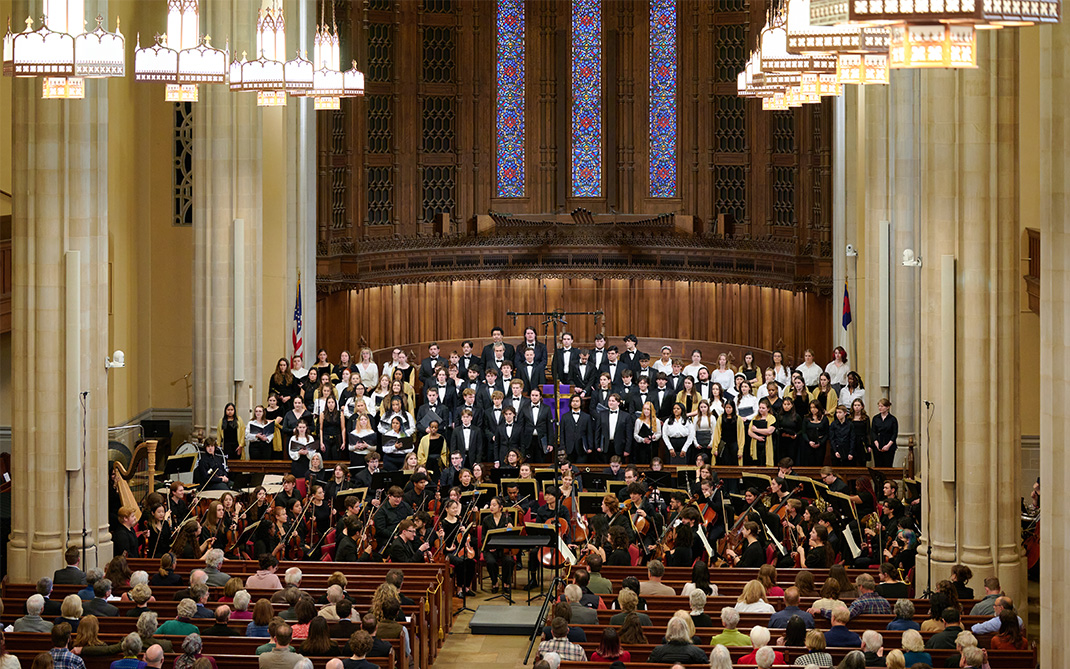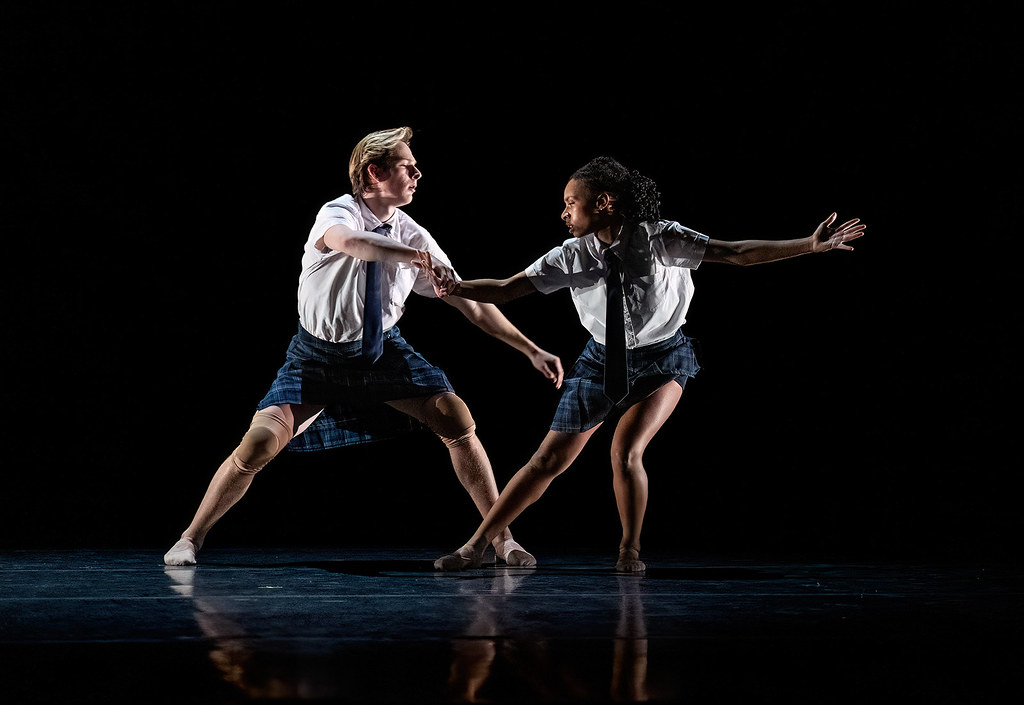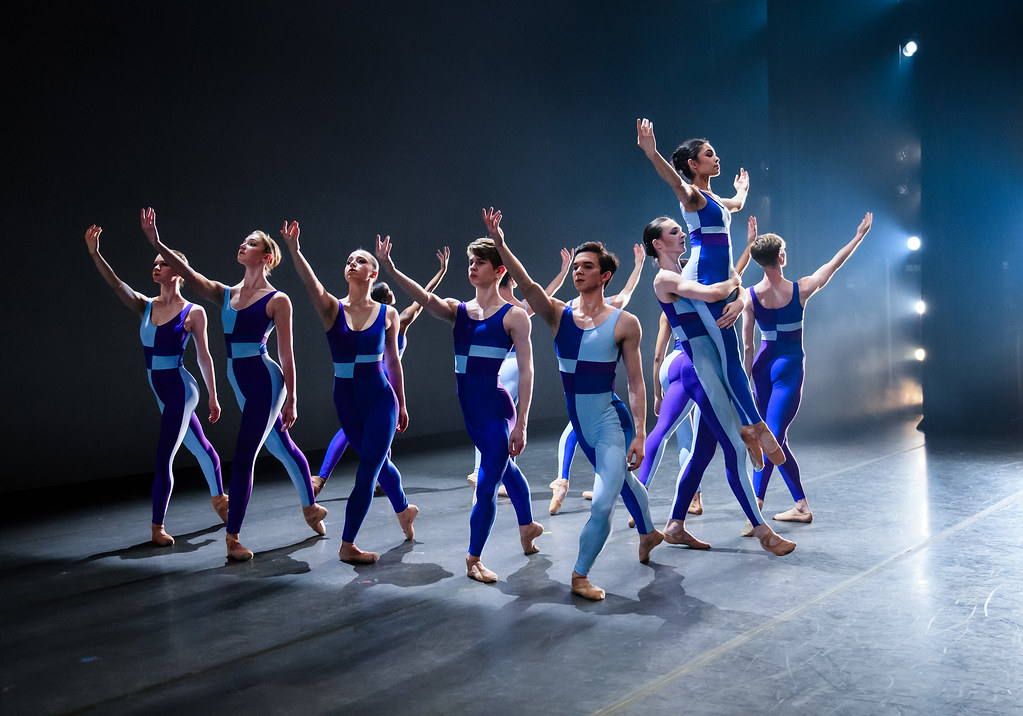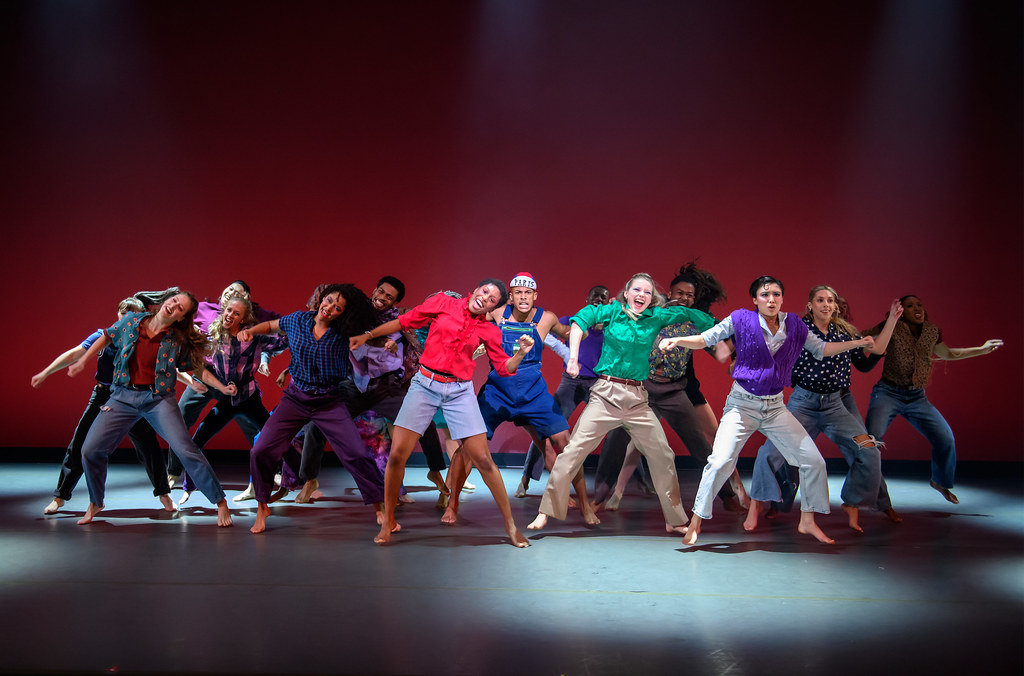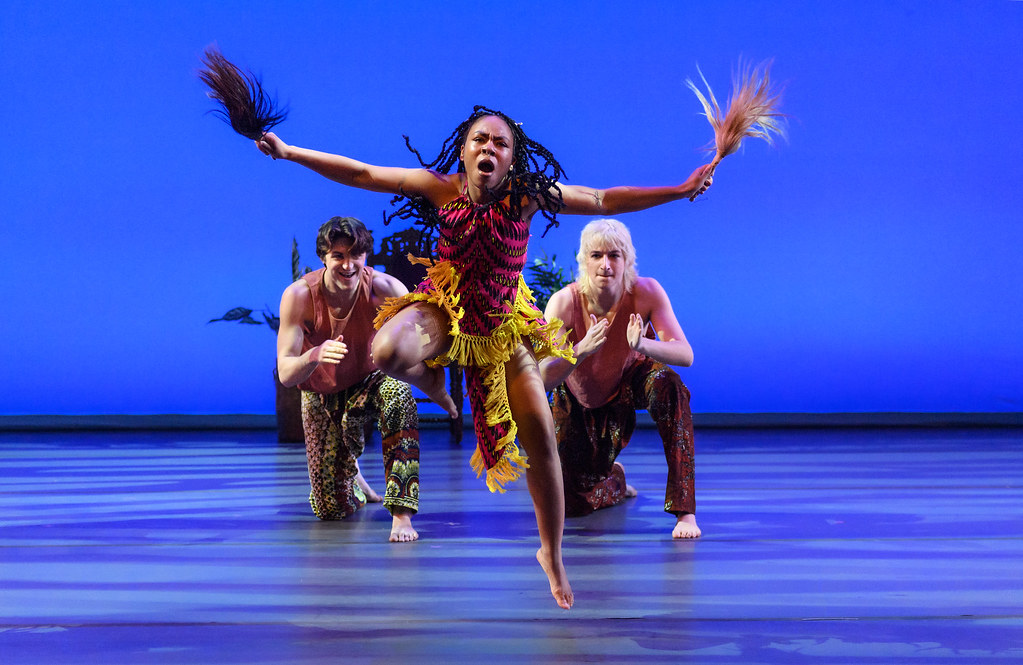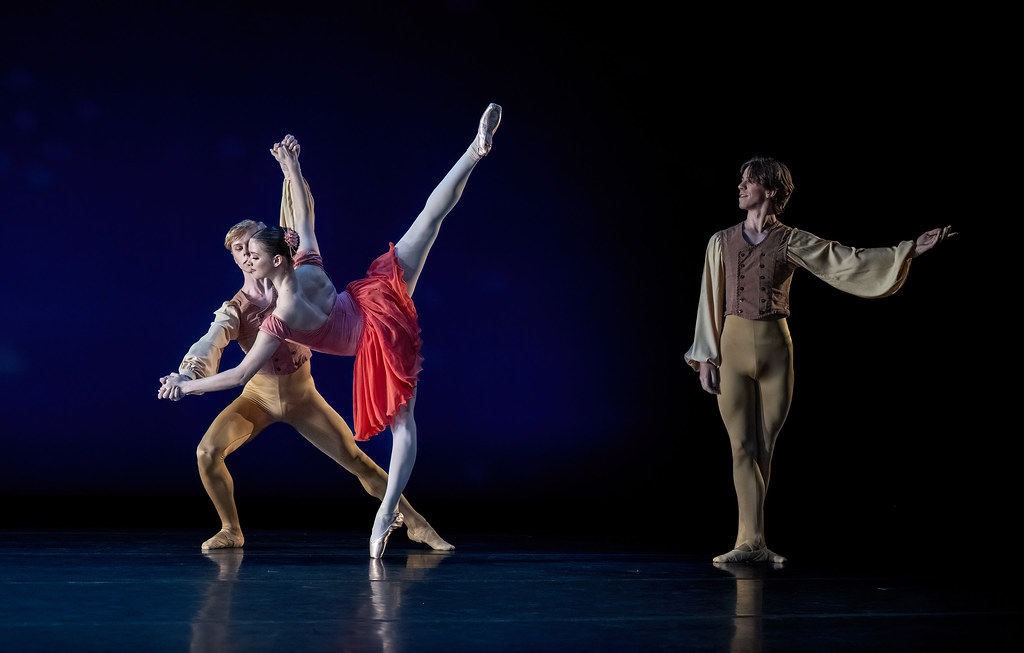Diverse dances, dynamic stories: UNCSA's Winter Dance celebrates inclusivity
The School of Dance dazzles audiences each February with the annual Winter Dance concert, showcasing talents of both contemporary and ballet dancers of all levels. For the first time, in a nod to Black History Month, the Winter Dance program exclusively highlighted choreographers of color.
Across four sold-out performances, audiences were treated to premieres of four original works: “A Symphony of Cracks, Part 1” by Rena Butler, “FINAL BUTTON” by contemporary dance alumnus Juel D. Lane (B.F.A. Dance ’02), “The Gardens That Were Watered for Us” by Sidra Bell, and “Death of a King” by faculty member Wesley L. Williams Jr. Additionally, the program included excerpts from Robert Garland’s “The Joplin Dances (Excerpts),” staged by Da’Von Doane and Courtney Cochran of Dance Theatre of Harlem.
An intentional program
The Winter Dance program began taking shape two years ago. “There’s always a thread to follow as we weave the program for our dance concerts,” explains Dean of Dance Endalyn T. Outlaw. “Sometimes it’s diverse representation with male and female choreographers, sometimes it’s emerging works and iconic works. Winter Dance is in February, and it seemed like a missed opportunity to not focus on artists of color.”
Outlaw first reached out to Princess Grace Award-winning contemporary choreographer Rena Butler to engage her as a guest artist. Working with a guest choreographer is an essential experience for students. “It’s important that all students have the opportunity to be in main stage performances and to work with amazing professionals who can connect them to the industry,” shares Outlaw. Often, students form lasting relationships with these guests, which can benefit them as they begin to search for work.
David Gouldin (H.S. Dance ’22, B.F.A. Dance ’25) rehearsed with Butler and her assistant, Madison Pineda Bender, for three weeks ahead of Winter Dance. He describes the exact experience Outlaw desires for students: “They treated us like professional, mature dancers and nurtured a space where we could all learn and grow together,” he says. “I was inspired by the relationship that Rena and Maddie share and the communication that is required for them to work together. It was exceptional. I will always remember Rena’s teachings and the authenticity she carries in life. I will try and channel that throughout my career.”
Outlaw also invited ballet choreographer and dance educator Sidra Bell to return to campus to create a new work for Winter Dance, after having served as a mentor for the 2023 Choreographic Institute. Bell collaborated with Music alumna and UNCSA Board of Trustees member Nia Imani Franklin (M.M. ’17) on the piece, with Franklin composing an original score. “Our new work celebrates sisterhood, Blackness, motherhood and growth,” says Franklin.
Supporting alumni talent
Franklin wasn’t the only alum working behind the scenes for Winter Dance this year. Juel D. Lane choreographed an original contemporary work for the occasion. Lane is currently serving as an adjunct professor in the School of Dance and as director of the 2024 Choreographic Institute. For his work, “The Final Button,” he had the assistance of alumna Gabrielle Loren (B.F.A. Dance ’18).
“Alumni are such a valuable asset for any program,” explains Outlaw. “They were directly in the shoes of the students, and some very recently. Any way I can get alumni to be part of the current student experience is very exciting.”
The opportunity to support alumni work while connecting them with current students is a passion for Outlaw. She recently developed a new initiative with support from the Thomas S. Kenan Institute for the Arts: the Alumni in Residence (AIR) Project. Through the AIR Project, Dance alumni work with students in myriad ways—as choreographers, or even as consultants helping to lay a solid foundation for students who are interested in entrepreneurship. Lane is one of four alumni visiting campus supported by the AIR Project this academic year.
“It is a wonderful opportunity to welcome Juel D. Lane back to campus to further his artistic work and to connect students to an artist who is deeply committed to effecting the change they wish to see in the world,” says Kevin Bitterman, executive director of Thomas S. Kenan Institute for the Arts. “Supporting UNCSA alumni through initiatives like the AIR Project underscores the Institute’s commitment to fostering connectivity between our campus community and creatives around the world. Through residencies like this, we continue to support members of the UNCSA community at all stages of their career development while also laying the foundation for future collaborations and the development of new work.”
Having this Winter Dance be entirely created and choreographed by people of color has brought an awareness to myself and my classmates about how important it is to not only choose to be inclusive and interested in learning, but to recognize and celebrate diverse ways that dance has existed in history
Vanessa Meikle (B.F.A. Dance ’24)
Dancers aren’t shy about sharing the impact of having Lane on campus to guide them through learning the new work. Contemporary dancer Addy Harris (B.F.A. Dance ’25) admired Lane’s personability while maintaining authority over the rehearsal, as well as his iterative process. “He could stick with an idea and allow it to evolve into many versions of itself until he was content with the end product,” she says.
Camille Ifé Pettiford (H.S. Dance ’22, B.F.A. Dance ’25) agrees. “Working with Juel was one of the most freeing and challenging spaces to work in,” she recalls. “He gave us the creative liberty to make choices and bring as much of ourselves as we could to the movement. I appreciated how he brought his authentic self into our rehearsal space with a love and respect for every person in the room.”
Representation on stage
“The Final Button,” tells the story of Black fashion designer Patrick Kelly who utilized buttons in many of his styles and pushed boundaries by addressing and reclaiming racist iconography in his work. “As an artist of color, I often see how choreographers and other artists of color aren’t highlighted for their work,” says Pettiford. “Black artists’ stories often aren’t published in mainstream history, and it’s crucial to recognize the impact they brought to the world. Most people don’t know Patrick Kelly’s story, and the fact that Juel took the time to dive into Patrick’s work demonstrates how big of an influence he was not only to the fashion industry, but to unrecognized Black artists everywhere.” Pettiford found value in the two roles she was selected to dance: one of Patrick Kelly’s muses/models and one of a shadow-like creature meant to resemble the backlash Kelly received from his interpretation of the golliwogg. “To help me understand the true context of my character, I researched the history of the golliwogg and what Patrick was conveying through his work. It was challenging to incorporate so many different aspects into a minute-long solo, but the deep dive into history was needed for such a poignant story.”
Wesley L. Williams’ “Death of a King” also brought meaningful representation as the Winter Dance finale—the first time a West African dance has been performed on the main stage at UNCSA. The piece tells the story of King Sundiata Keita, who founded the Mali empire, ruled in the 13th century and was loved by his people.
“I approached Wesley about developing the piece,” says Outlaw. “I wanted something that was very cultural and very celebratory, in a way. ‘Death of a King’ has many narratives, and it is a very colorful and festive finale.”
“The most exciting part of the piece for me was jon don, the emotional segment of the story,” says Marius Diaz (B.F.A. Dance ’26). “The scene was enormously powerful, as it resembles overcoming hardships. Dancers started on the floor weeping, feeling weak without their king, but they got up stronger than ever. Jon don is a traditional slave dance, and in this piece it resembles strength and resiliency through times of change.”
“Death of a King” ends on a note of triumph and celebration, bolstered by a soaring score. With support from the Thomas S. Kenan Institute for the Arts, West African balafon player Famoro Dioubate traveled to Winston-Salem to work with and perform alongside students, deeply intertwining West African music and West African dance.
Restaging ragtime
Miles across the world from West Africa, the syncopated styles of ragtime music originated in African-American communities in Kentucky, Missouri and Texas. Inspired by the “King of Ragtime” Scott Joplin and other ragtime composers, Dance Theatre of Harlem company member (now Artistic Director) Robert Garland premiered “Joplin Dances” in 1995. Dean of Dance Endalyn T. Outlaw (née Taylor) performed in the original cast.
Vanessa Meikle (B.F.A. Dance ’24) stepped into the same role for Winter Dance this year. “What was most exciting to me was simply the fact that we were allowed to have fun dancing,” she recalls. “It’s not often that the character you get to portray on stage is just you, feeling joy and connection with the dancers with whom you’re sharing the space.”
The excitement translates to the overall program as well. “Having this Winter Dance be entirely created and choreographed by people of color has brought an awareness to myself and my classmates about how important it is to not only choose to be inclusive and interested in learning, but to recognize and celebrate diverse ways that dance has existed in history,” says Meikle. “And it’s exciting because we had the opportunity to do this through learning the work, first hand, from people who have danced it.”
“As a Black dancer, to learn from people who have had similar experiences in dance made the whole rehearsal experience so memorable and enjoyable,” adds fellow “Joplin Dances” performer Nifa Aulo Omondi (H.S. Dance ’24).
Future representation in programming
Winter Dance was an important moment for the community, and especially for student artists who performed on stage. “Growing up, my parents made sure I saw people of color in all kinds of places—but especially on stage,” says Harris. “Representation has the ability to impact a wide range of people and allow them to feel that there is a space for them in whatever they aspire to do.”
It is Outlaw’s hope to program something every year that celebrates diverse groups—Asian, indigenous or Latinx choreographers, for example.
It’s important that all students have the opportunity to be in main stage performances and to work with amazing professionals who can connect them to the industry.
Dean of Dance Endalyn T. Outlaw
“I’m filled with gratitude and excitement for the opportunity to be able to curate programming that speaks directly to our strategic plan, and for the work other schools at UNCSA are doing along these lines as well,” says Outlaw. “The more we make bold actions around the statements in our plan, the better we will draw our community to us. We value that community and all of the different ways that we can come together.”
Get the best news, performance and alumni stories from UNCSA.
SUBSCRIBE TO OUR NEWSLETTERS(OPENS IN NEW TAB)(OPENS IN NEW TAB)(OPENS IN NEW TAB)(OPENS IN NEW TAB)(OPENS IN NEW TAB)(OPENS IN NEW TAB)(OPENS IN NEW TAB)(OPENS IN NEW TAB)(OPENS IN NEW TAB)(OPENS IN NEW TAB)
March 06, 2024
